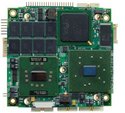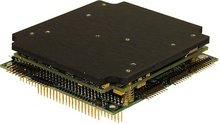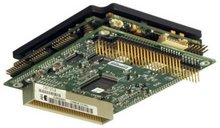“Pins down” PC/104 SBCs resist shock, temperature extremes
Nov 28, 2007 — by LinuxDevices Staff — from the LinuxDevices Archive — 2 views Rugged board specialist Parvus has announced two PC/104-Plus form-factor single board computers (SBCs) aimed at military or commercial applications that involve high shock, vibration, and/or temperature extremes. The CPU-1472 and CPU-1474 feature soldered-in RAM and structural heat spreader plates, according to the company.
Rugged board specialist Parvus has announced two PC/104-Plus form-factor single board computers (SBCs) aimed at military or commercial applications that involve high shock, vibration, and/or temperature extremes. The CPU-1472 and CPU-1474 feature soldered-in RAM and structural heat spreader plates, according to the company.
(Click here for a larger view of the Parvus CPU-1472)
The CPU-1472 and CPU-1474 are both based on Intel Celeron CPUs clocked at 1GHz, with 512KB second-level caches and 400MHz frontside buses. Whereas the CPU-1472 features a single Intel 82562-based 10/100 Ethernet controller and eight USB ports, the CPU-1474 adds an Intel 82541-based gigabit Ethernet controller, but has only four USB ports.
Like a few other products — the recently-introduced Hectronic H6036 for example — the Parvus devices generally follow the PC/104 form factor, but deploy their connectors in a male, “pins down” configuration. This means they can reside only at the top of a multi-module PC/104 stack, or else be paired with a custom application baseboard.


Parvus CPU 147x, top and bottom
(Click either view to enlarge)
An advantage of this design choice is that an aluminum thermal interface plate — supplied with the SBCs, and visible in the photos above — can be attached to the devices with a gap pad or coupling compound. According to Parvus, this plate provides reliable fanless operation and, if attached via another gap pad to a suitable metal enclosure, an extended operating range from -40 to 85 deg. C (-40 to +185 deg. F).
Features and specifications listed by Parvus for the CPU-1472 and CPU-1474 include:
- Processor — Intel Celeron clocked at 1GHz, with 512KB second-level cache and 400MHz frontside bus
- Memory — 512MB of 266MHz DDR RAM (PC2100), soldered on board
- Networking:
- CPU-1472 — 1 x 10/100 Ethernet (Intel 82562-based
- CPU-1474 — 1 x 10/100 Ethernet (Intel 82562-based), 1 x Gigabit Ethernet (Intel 82541-based)
- CPU-1472 — 1 x 10/100 Ethernet (Intel 82562-based
- Other I/O:
- 8 x USB (CPU-1472)
- 4 x USB (CPU-1474)
- analog VGA and digital LVDS video outputs
- IDE ATA 100 controller
- AC '97 audio interface (use requires accessory adapter)
- keyboard, mouse and auxiliary power
- 8 x USB (CPU-1472)
- Expansion — male PC/104 (ISA) and PC/104-Plus (PCI) connectors
- Dimensions — 3.8 x 3.6 x .75 inches, excluding connectors
- Power requirements — +5VDC, 9.5 W typical consumption (13.5 W max)
Parvus says that for “first time users and to ease rapid implementation,” its CPU development kit (DTK) is highly recommended. This includes either the CPU-1472 or CPU-1474, along with a baseboard that offers serial, parallel, and PS/2 ports plus adapters to standard PCI and ISA buses.
The DTK also includes floppy and hard drives, a CD-ROM reader, and cables that provide standard connectors. Therefore, the unit can be connected to a keyboard, monitor, and mouse, then used as if it were a standard PC.
According to Parvus, both SBCs are compatible with Linux, Windows XP Embedded, Windows CE, VxWorks, and QNX operating systems. More information is available from the company's Web site, here.
This article was originally published on LinuxDevices.com and has been donated to the open source community by QuinStreet Inc. Please visit LinuxToday.com for up-to-date news and articles about Linux and open source.